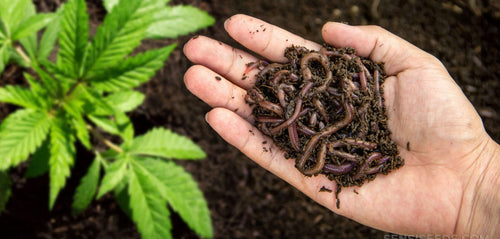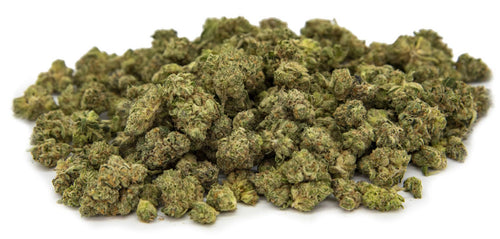#33: Unlocking the Secrets of Terpenes: The Aromas That Define Your High
#33: Unlocking the Secrets of Terpenes: The Aromas That Define Your High
Do you ever wonder how certain scents can instantly transport you to a different time and place? Or how the aroma of fresh flowers can bring a sense of calm and relaxation? The power of fragrance goes far beyond just pleasant smells, as it has been used for centuries in aromatherapy to promote physical and mental well-being.
The relaxing effects of lavender oil or the energizing properties of citrus oils are due to the specific terpenes found in each plant. Terpenes are naturally occurring organic compounds that give plants their unique aromas and flavours. They also have many therapeutic properties, such as anti-inflammatory and antiseptic qualities.
In the cannabis plant, terpenes play an important role in determining the effects of different strains. These fragrant oils play a significant role in the effects that each strain produces, from uplifting and energizing to relaxing and calming. For example, a strain high in linalool will likely have a floral aroma and may offer calming effects.
By understanding the different types of terpenes found in cannabis, you can better understand how specific strains will affect your mood and experience. This knowledge can help you make informed decisions when selecting a strain, allowing you to better tailor your cannabis experience.
In this article, we'll explore the world of terpenes and uncover the secrets behind their unique aromas and effects. We'll take a closer look at the science behind these compounds and how they interact with other cannabinoids in cannabis. Are you ready to unlock the mysteries of terpenes and learn more about the aromas that define your high? Let's get started!
The power of scent: How terpenes shape your cannabis experience
Terpenes are the aromatic compounds responsible for the distinct flavours and scents found in many plants, including cannabis. They are produced as a natural defence mechanism to repel predators and attract pollinators. Terpenes can be found in a wide range of plants, from citrus fruits to lavender and even coniferous trees.
These fragrant oils have a diverse range of uses in various industries and applications, from cosmetics to cleaning products. Limonene, for example, is commonly used as a food additive and flavouring agent. Terpenes are also used in perfumes and aromatherapy for their potential therapeutic benefits.

The chemical structure of terpenes determines their unique properties and potential benefits. Terpenes are made up of isoprene units, which determine their specific structure and function. Different terpenes have different properties, making it essential to understand the specific terpene profiles of different strains of cannabis.
Scientific research has shown that terpenes interact with other compounds in cannabis, such as cannabinoids, to produce a variety of effects. This interaction, known as the entourage effect, describes how the combined effects of all the compounds in cannabis create a more significant impact than any individual compound alone.
Terpenes can also interact with the human body through our sense of smell and taste. When we consume cannabis, our olfactory system detects the specific terpenes present in the strain, which can influence the overall effects of the plant. For example, the terpene myrcene is thought to have sedative effects, while limonene may have uplifting and energizing effects.
Understanding the science behind terpenes and their potential therapeutic benefits can help us unlock the full potential of cannabis. Whether you're looking for stress relief or pain reduction, terpenes can play a significant role in achieving your desired effect.
From citrus to pine: The many aromas of cannabis terpenes
There are over 100 different terpenes found in cannabis, each with its own distinct aroma and potential therapeutic benefits. Here are some of the most common types of cannabis terpenes and their properties:
Myrcene: This is one of the most prevalent terpenes found in cannabis, and it has a musky, oak scent. Myrcene is known for its sedative effects and potential pain relief properties. It enhances the psychoactive effects of THC and is commonly found in indica strains.
Limonene: As the name suggests, this terpene has a citrusy aroma and is thought to have uplifting and energizing effects. Limonene is known for its focus-enhancing and appetite-stimulating properties and is commonly found in sativa strains.

Caryophyllene: Woody, spicy and peppery, caryophyllene is found in many culinary herbs such as black pepper and basil. It is thought to have anxiety-relieving and depression-fighting properties, making it a popular choice for those seeking relief from stress.
Linalool: Floral in scent, linalool is found in many flowers and herbs such as lavender. It has a variety of potential therapeutic benefits, including sleep aid, anti-inflammatory, and anxiety relief.
Humulene: With a woody, earthy scent, humulene is found in hops and various herbs. It has potential anti-inflammatory properties and appetite-suppressant effects. It is commonly found in both sativa and indica strains.
Pinene: The fresh, piney scent of this terpene is found in many coniferous plants. Pinene has potential cognitive benefits and is thought to enhance alertness and focus, as well as promote respiratory health.
Terpinolene: A fresh, floral aroma, terpinolene is found in many plants such as lilac and cumin. It has potential sedative effects and is thought to possess pain relief and anti-inflammatory properties.

Nerolidol: Sweet and woody in aroma, nerolidol is found in many fruits and flowers such as ginger and jasmine. It is thought to have sleep and relaxation-promoting effects and is commonly used in aromatherapy for its calming properties.
Farnesene: Sweet and floral in aroma, farnesene is found in many plants such as green apples and basil. Farnesene has potential focus-enhancing and calming properties and is thought to have anti-inflammatory effects.
Ocimene: Herbs such as parsley and mint have a distinct scent due to their high concentration of ocimene. This terpene is uplifting and energizing, making it great for those seeking an alertness boost.
Bisabolol: This terpene has a light, floral aroma and is found in chamomile flowers. Bisabolol may help induce relaxation and reduce inflammation. It is often used in skin care products for its anti-inflammatory and soothing properties.
Valencene: If you've ever smelled the distinct citrusy aroma of Valencia oranges, then you already know what valencene smells like. It has potential relaxant and anti-inflammatory properties.
Sabinene: Coniferous trees such as pine and fir have a distinct woody scent due to their high concentration of sabinene. This terpene may help induce a relaxant effect and provide pain relief.
By understanding the different types and potential therapeutic benefits of cannabis terpenes, you can unlock the full potential of cannabis. With this knowledge, you can choose strains that target your specific needs in order to achieve optimal results. From stress relief to pain reduction, terpenes may play a significant role in reaching your desired effect.
Getting the most out of your cannabis: Tips for using terpenes
Now that you're familiar with the different types of terpenes and their potential effects, let's discuss how you can use them to your advantage. Here are some tips on how to make the most out of your cannabis terpene experience.
Choose strains based on terpenes - When selecting a strain, it's important to consider the terpene profile of that particular strain. Make sure to choose a strain that contains terpenes with potential effects that match your desired outcome.
Pay attention to the aroma: Different strains have a variety of aromas due to the terpenes present in them. When choosing a strain, take the sniff test and pay attention to which smells resonate with you. Doing so can help you decide which strain may be best for you.
Consider terpene combinations: When selecting a strain, consider not only the individual terpenes present but also the combination of them. For example, some terpenes are better at providing relaxation effects when used together. Knowing which combinations work best for you can help you achieve your desired effect more quickly and effectively.
Pair terpenes with other compounds: Terpenes work in conjunction with other compounds in cannabis, such as cannabinoids, to produce various effects. For example, cannabidiol (CBD) and myrcene, a terpene found in many cannabis strains, can work together to increase relaxation.
Experiment with different consumption methods: Different methods of consumption can affect the effects of terpenes. For example, vaporizing cannabis allows for more direct and intense delivery of aromas and flavours, while edibles take longer to kick in but may last longer due to their slow-release profile.
Now that you know more about the potential effects of different types of terpenes and how to use them to enhance your cannabis experience, you can tailor your consumption for a more personalized medicinal effect. Terpenes are complex compounds with a variety of potential effects, so it's important to keep experimenting until you find the perfect blend for your desired results.
Elevate your cannabis experience with terpenes
We hope this guide has provided you with an informative and engaging introduction to the world of cannabis terpenes. Understanding the unique properties and potential therapeutic benefits of different terpenes can help you make more informed decisions when selecting strains to consume, potentially enhancing your overall cannabis experience.
Whether you're looking for relaxation, pain relief, or an energy boost, incorporating terpenes into your cannabis experience can help you achieve your desired effect more effectively. So, the next time you consume cannabis, take a moment to appreciate the unique aroma and flavour of the terpenes present in the strain and use them to enhance your overall experience.











